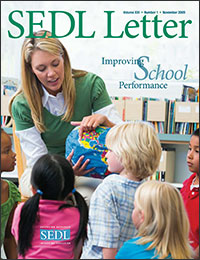Imagining the Possibilities: SEDL Begins National Study of Well-Known Reading Program
Published in
SEDL Letter
Vol. XXI, Number 1, November 2009,
Improving School Performance
Evidence from decades of research suggests that with appropriate instruction nearly all students can become competent readers (Denton & Mathes, 2003; Lyon, Fletcher, Fuchs, & Chhabra, 2006; Mathes & Denton, 2002; Snow, Burns, & Griffin, 1998). Yet, statistics indicate that 67% of fourth-grade students fail to reach proficient-level reading scores (National Center for Educational Statistics, 2007). Recent initiatives emphasize the critical role of early reading instruction in preventing reading difficulties and recognize that students who do not learn to read well by third grade are less likely to build vocabulary and interact with a wide variety of texts (Good, Simmons, & Kame’enui, 2001). Such failure can have a long-term impact on children’s self-confidence, motivation to learn, performance in school, and success in life (Harris & Sipay, 1990; Juel, 1988; Stanovich, 1986, 2000). In addition, reading difficulties are the most common reason for referral into special education (Donovan & Cross, 2002).Effective core reading curricula can play an important role in helping students learn to read. Only a few reading curricula reviewed by the What Works Clearinghouse (WWC, 2007) have potentially positive effects, however. Studies reviewed by WWC focus on randomized controlled trials, the most rigorous research design according to the U.S. Department of Education’s Institute of Education Sciences (IES); but few, if any, of the studies reviewed have been large enough to produce findings that policymakers and educators can apply to a variety of instructional settings. Findings from large-scale trials, especially those that allow comparison between reading programs that are among the highest sellers in the core reading program market, stand to contribute unique evidence to the educational curricula and policy reform debates.
Adding to the available research, SEDL’s Research and Evaluation work group has begun a rigorous 4-year study of Imagine It!, the next generation of McGraw-Hill Education’s Open Court Reading series. The series is a core reading program that has been widely used since the 1960s. Two prominent researchers will head up the project, which will include key SEDL researchers and an esteemed panel of technical advisors. Michael Vaden-Kiernan, director of Research and Evaluation for SEDL, is the principal investigator for the project. Geoffrey Borman, professor of education at the University of Wisconsin–Madison and deputy director of the university’s Predoctoral Interdisciplinary Research Training Program, will serve as co-principal investigator. “This is a much-needed and timely study to provide more rigorous evidence regarding the effectiveness of a reading program that has been around for many decades and has been scaled up to a national level,” explains Vaden-Kiernan. The project is supported by SEDL project director Debra Hughes Jones and program associate Sarah Caverly, both of whom attended an IES-funded training opportunity on the latest designs and methods for conducting experimental studies.

A limited but growing body of research has examined the impact of the Open Court Reading series on student reading outcomes and the program’s promise in preventing reading difficulties. Findings suggest that Open Court Reading, as compared to other reading programs, is associated with significantly better student outcomes and may be particularly effective with low-performing students (EdSource, 2006; McRae, 2002; Skindrud & Gersten, 2006). Despite the program’s widespread use and promising research findings, a rigorous and large-scale evaluation has not been conducted. The SEDL study will be the first large-scale, externally funded, third-party evaluation of Open Court Reading. “There have been few large-scale randomized trials that test the effectiveness of replicable educational interventions deployed across many schools,” says Borman. “This is an exciting opportunity to study Imagine It!, and the results are sure to be of considerable consequence to policymakers, researchers, and educational practitioners across the nation.”
One of the largest of its kind, the study will use a multisite cluster randomized trial design. It will include school districts in rural, urban, and suburban locations across the United States and is intended to produce findings that can be applied to a wide range of educational settings. Researchers will investigate whether Imagine It! shows significant positive effects on reading outcomes for students in kindergarten through fifth grade and how the effects vary across students, schools, and districts. “Our goal in conducting this study is to provide policymakers and practitioners with evidence to make decisions about program adoptions that can be costly, both literally and in terms of time and teacher resources, before noticeable improvements in student reading are achieved,” explains Jones. “By conducting a national study, we will be able to test whether Imagine It! has positive effects on students when implemented under normal conditions and in a variety of settings. This has the potential to offer sound evidence about a widely used reading program, which would advance the field significantly.”
SEDL’s project is currently underway. The first-year planning period includes critical activities that will affect the success of the overall study, and researchers have begun recruitment planning to find districts to participate in the study. In addition, SEDL has enlisted a panel of reading experts and nationally recognized methodologists to participate in a consortium version of the technical working group. The working group has revisited the project design and discussed critical elements of sampling and recruitment strategies, the first major activity undertaken this year. Along with the principal investigators, Vaden-Kiernan and Borman, the following national experts are members of the working group: Russell Gersten, executive director of the Instructional Research Group and professor emeritus, College of Education, University of Oregon; Thomas Cook, professor of sociology, psychology, education, and social policy at Northwestern University; Johannes Bos, vice president of Education, Human Development and the Workforce at American Institutes for Research; and Carol Connor, associate professor, Florida State University, College of Education, Reading and Language Arts, and research faculty at the Florida Center for Reading Research. “The working group discussed and made recommendations regarding the design of the research, the comparison group, and classroom observations,” says Connor. “These recommendations contributed to an already rigorous study design.”
References
- Denton, C. A., & Mathes, P. G. (2003). Intervention for struggling readers: Possibilities and challenges. In B. R. Foorman (Ed.), Preventing and remediating reading difficulties: Bringing science to scale (pp. 229–251). Timonium, MD: York Press.
- Donovan, M. S., & Cross, C. T. (2002). Minority students in special and gifted education. Washington, DC: National Academy Press. Retrieved from www.nap.edu/catalog/10128.html
- EdSource. (2006). Similar students, different results: Why do some schools do better? Retrieved from www.edsource.org/pub_SimStu6-06_SummaryReport.html
- Good, R. H. M., Simmons, D. C., & Kame’enui, E. J. (2001). The importance and decision-making utility of a continuum of fluency-based indicators of foundational reading skills for third-grade high-stakes outcomes. Scientific Studies of Reading, 5, 257–288.
- Harris, A. J., & Sipay, E. R. (1990). How to increase reading ability: A guide to developmental and remedial methods (9th ed.). New York: Allyn & Bacon.
- Juel, C. (1988). Learning to read and write: A longitudinal study of 54 children from first through fourth grades. Journal of Educational Psychology, 80, 437–447.
- Lyon, G. R., Fletcher, J. M., Fuchs, L., & Chhabra, V. (2006). Learning disabilities. In E. Mash & R. Barkley (Eds.), Treatment of childhood disorders (3rd ed., pp. 512–591). New York: Guilford Press.
- Mathes, P. G., & Denton, C. A. (2002). The prevention and identification of reading disability. Seminars in Pediatric Neurology, 9, 185–191.
- McRae, D. J. (2002). Test score gains for Open Court schools in California: Results from three cohorts of schools. Retrieved from www.sraonline.com/download/OCR/Research/testscoresgain.pdf
- National Center for Educational Statistics. (2007). National assessment of educational progress: 2007 reading assessments. Washington, DC: U.S. Department of Education, Institute of Education Sciences.
- Skindrud, K., & Gersten, R. (2006). An evaluation of two contrasting approaches for improving reading achievement in a large urban district. The Elementary School Journal, 106 (5), 389–407.
- Snow, C. E., Burns, M. S., & Griffin, P. (Eds.). (1998). Preventing reading difficulties in young children. Washington, DC: National Academy Press.
- Stanovich, K. E. (1986). Matthew effects in reading: Some consequences of individual differences in the acquisition of literacy. Reading Research Quarterly, 21, 360–407.
- Stanovich, K. E. (2000). Progress in understanding reading: Scientific foundations and new frontiers. New York: Guilford Press.
- What Works Clearinghouse. (2007, August). What Works Clearinghouse topic report: Beginning reading. Washington, DC: U.S. Department of Education, Institute of Education Sciences. Retrieved from http://ies.ed.gov/ncee/wwc/pdf/BR_TR_08_13_07.pdf
Next Article: Uncharted Territory: Using Tiered Intervention to Improve High School Performance

